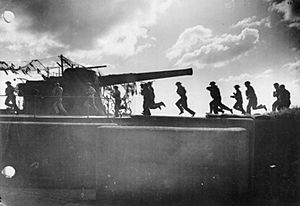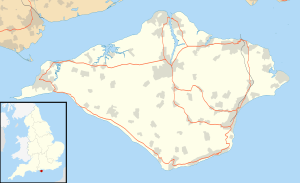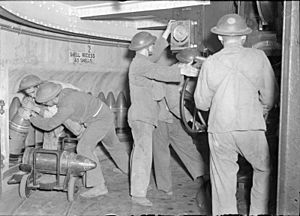Culver Battery facts for kids
Quick facts for kids Culver Battery |
|
|---|---|
| Culver Down, Isle of Wight, England | |

A crew from 118th Battery ready one of the two 9.2 inch gun coastal defence guns for action at Culver Point Battery, August 1940
|
|
| Coordinates | 50°39′58″N 1°05′53″W / 50.666128°N 1.097917°W |
| Site information | |
| Controlled by | National Trust |
| Open to the public |
Yes |
| Condition | Ruined |
| Site history | |
| Built | 21 July 1906 |
| Built by | British Army |
| Materials | Concrete |
| Demolished | 1956 |
| Events | First World War Second World War |
| Garrison information | |
| Garrison | 527th Coast Regiment |
Culver Battery is an old fort with big guns near the sea. It sits on Culver Down, on the eastern side of the Isle of Wight, England. This fort was one of many Palmerston Forts built on the island. These forts were made in the late 1800s because Britain was worried about the strong French Navy.
Culver Battery was used during both the First World War and the Second World War. It stopped being used in 1956.
Contents
Why Was Culver Battery Built?
People first thought about building a fort on Culver Down in 1887. Its main job was to protect other forts nearby, like Yaverland and Redcliff. It would stop enemy ships from shooting at them easily from the side.
The first plan was for the fort to have three large 6-inch guns. It would also have two smaller 6-pounder guns to help out. These guns were special because they could disappear into the ground after firing. This made them harder for enemies to hit.
However, there were some arguments about building the fort. Some people thought the disappearing guns were not needed because Culver Down is already very high up on a cliff, about 300 feet (91 meters) above the sea. Because of these disagreements, building the fort was delayed.
Building the Fort
Culver Battery was finally built between May 1904 and July 1906. The main parts of the fort were made from brick and strong reinforced concrete. It had two large gun positions, each with a fixed platform called a barbette. On these platforms sat two very powerful 9.2-inch guns.
In 1906, a report from the Royal Engineers said the fort was almost finished. The ammunition for these huge guns was kept safely underground in magazines. These magazines were built between the two gun positions. The fort was designed to be very strong against attacks from the sea.
The 9.2-inch guns at Culver Battery were not meant to protect Sandown Bay right below it. Instead, they could fire very far, all the way to Spithead. This meant they could hit any enemy ship trying to enter The Solent, which is the strait between the Isle of Wight and mainland Britain. The fort's control center was in the same building as the Port War Signal Station, located nearby.
Culver Battery in the First World War
During the First World War, Culver Battery's main job was to protect the Isle of Wight's torpedo boats' anchorage. It guarded against long-range attacks from enemy ships called cruisers.
Life at the battery during wartime included toilets, washrooms, a mess hall, and storage rooms. There was also a workshop and a telephone room. When the gun crews were not on duty, they lived in barracks at Bembridge Fort. Ammunition was stored in strong underground magazines behind the gun positions. Extra shells and cordite (a type of gunpowder) were kept at Bembridge. Besides the two big coastal guns, the battery also had a 6-pounder Hotchkiss gun. This smaller gun was used to shoot at enemy aircraft.
Between the World Wars
After the First World War, between 1922 and 1924, the gun platforms at Culver Battery were updated. New mounts were added that let the guns point higher, up to 30 degrees. This made them able to shoot even further, beyond 6,000 yards (5,486 meters).
In 1927, Culver Battery was used to test a new system called the Fortress Plotting system. This was an experimental way to make coastal guns more accurate. In 1934, three 6-inch guns were temporarily put in place for more long-range shooting tests. An experimental twin-6 pounder gun was also installed in the mid-1930s to test new ways of controlling gun fire.
Culver Battery in the Second World War
When the Second World War started in 1939, soldiers from the 118th Battery of the 527th Coast Regiment were stationed at Culver Down. The two main guns now had a range of up to 17,000 yards (15,545 meters). This meant they could help Nodes Point to stop long-range attacks on Spithead or Portsmouth Dockyard.
By 1942, people were less worried about a German invasion. So, the battery no longer needed to be on full-time night alert. In 1943, a special radar station was built just east of Culver Battery. This radar helped detect enemy ships and aircraft.
After the Wars and Closing Down
In 1947, two 6-inch naval guns were set up in front of the 9.2-inch guns. These were used for testing high-angle shooting. Two heavy 3.7-inch anti-aircraft guns were also used for practice.
In 1956, the Ministry of Defence decided to close Culver Battery. The guns, the fire control center, storage rooms, and living quarters were all removed. The site was then covered with earth. However, in 1966, the gun positions were dug up again to make them easier to see.
Today, Culver Battery is a public viewing point and picnic area. It is owned and managed by the National Trust.
Images for kids




